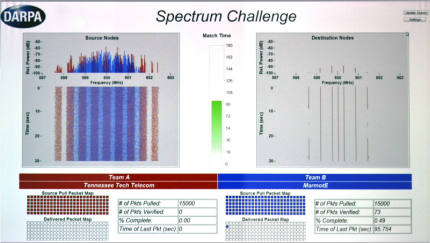Spectrum Challenge: Can software-defined radios defeat jamming?
Eighteen teams will both duel and work together in DARPA’s effort to find radio protocols that can function in contested electromagnetic environments.

In the increasingly crowded radio-frequency spectrum, military radios sending critical messages run the risk of interference, whether accidental or, more likely, intentional. Since the spectrum is finite and radio communications aren’t going away, the ideal would be to have robust radios that can function even in contested environments.
That’s the idea behind the Defense Research Projects Agency’s Spectrum Challenge, a year-long effort that will wrap up March 19-20 with 18 teams competing in the finals. The goal, is to use software-defined radios to find a protocol that can best deliver communications amid “other dynamic users and interfering signals,” DARPA said.
The teams, which all competed in an earlier competition in September 2013, will square off in a series of competitive and cooperative matches. The competitive matches will be a series of head-to-head contests teams jam each other’s signals while trying to get their own signals through, while operating within a defined 5 MHz ultra-high frequency band. In the cooperative matches, groups of three teams will collaborate on sharing spectrum to see which group can transmit their data in the least amount of time.
DARPA supplies each team with identical hardware and data — the competition is among their software algorithms.
At the previous competition, teams from Northeastern University and Vanderbilt University scored highest, each taking home a top prize of $25,000. Winners of the finals will get $50,000 each, with DARPA expecting to distribute $150,000 in prizes overall. The 18 competing teams were chosen from among 90 that had taken part in a preliminary phase last spring.
One advantage of having two competitions with the same teams is that they can learn from the first round and adjust to the differences between attacking and cooperating. Vanderbilt’s MarmotE team, which won the competitive tournament, plans to change strategies this time with regard to the cooperating.
“The preliminary tournament dramatically changed our thinking about the Cooperative Challenge,” team leader Peter Volgyesi, a research scientist at Vanderbilt’s Institute for Software Integrated Systems, said in a post on the school’s website. “Our team will focus on developing a truly adaptive strategy for the next event. This involves a completely new radio design and a drastic departure from the competitive radio architecture.”
Other teams such as Northeastern, which won the cooperative challenge and finished third in the competitive challenge, likewise will adjust. After the September competition, Guevara Noubir, a professor in the school’s College of Computer and Information Science — and who helped create the first 3G wireless network in the 1990s — said the focus will be on improving. “We’ll be spending the next six months making smarter techniques on top of the foundation we’ve already created,” he said.
This month’s competition will be held at DARPA Conference Center in Arlington, Va., and attendees are welcome. Anyone interested in attending can register here.
NEXT STORY: With R&D budgets, high risk has its rewards




